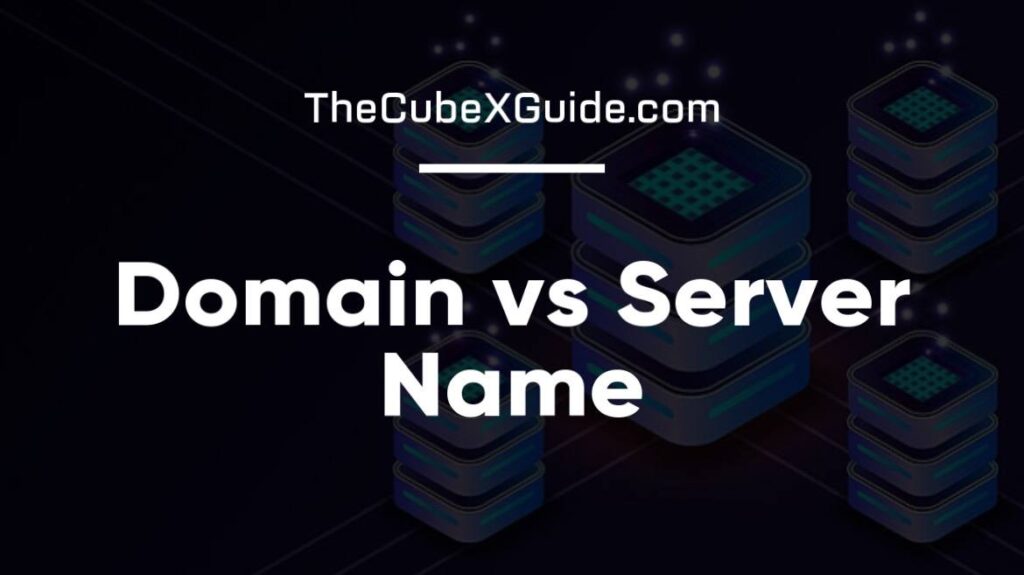The terminology used in website building may be a little perplexing if you’re new to it. Server name and domain are two concepts that frequently lead to misunderstandings. Despite being very similar, they are not the same thing. This post will explain the distinctions between domain and server names and show why doing so is crucial for anyone trying to build a successful website.
What is a Domain Name?
In essence, a domain name serves as the internet address for your website. It’s a distinctive name that distinguishes your website and makes it accessible to users. A domain name entered into your browser is translated into an IP address that is used to find the server hosting your website. For instance, your browser converts “google.com” into an IP address (172.217.1.46) that is then used to find Google’s server.
The top-level domain (TLD) and the second-level domain make up a domain name. (SLD). The TLD is the component of a domain name that comes after the dot, such as.com,.org,.net, and so forth. The SLD, which comes before the dot, contains the specific name that distinguishes your website. For instance, “example” is the SLD and “.com” is the TLD in the domain name “example.com”.
Why is Choosing the Right Domain Name Important?
Because it can affect your website’s visibility, brand awareness, and search engine optimization, picking the appropriate domain name is crucial. (SEO). Your domain name ought to be memorable, pertinent to your company or brand, and distinct. Additionally, it should be simple to say and spell so that potential visitors may locate your website with ease. Additionally, because it’s one of the things search engines take into account when ranking websites, your domain name may have an impact on your website’s SEO.
What is a Server Name?
The name assigned to the server that hosts your website is referred to as a server name or hostname. In order to retrieve the website’s files and data when someone visits your website, their computer talks with the server. The server name is essentially the server’s internet address. A server name might be “www.example.com” or “mail.example.com,” for instance.
Users typically don’t directly interact with server names because they are typically used for administrative purposes alone. However, as it’s required for setting up and maintaining your website, understanding your server name is crucial. To connect to your server and upload files to your website, for instance, you’ll need to know your server name.
What’s the Difference Between a Domain Name and a Server Name?
A domain name is used to identify your website, but a server name is used to identify the server that hosts your website. This is the key distinction between a domain name and a server name. A server name is comparable to a flat number in a building, whereas a domain name is like the street address of your website.
Another significant distinction is that server names are typically set up by the web hosting provider that serves your website, whereas domain names are typically registered with a domain registrar. Your website will be given a server name when you join up for a web hosting provider.
Finally, server names are typically exclusively visible to website managers and hosting companies, whereas domain names are typically public and open to anybody who wants to view your website.
Conclusion
Anyone hoping to build a successful website must comprehend the distinction between domain names and server names. Despite their similar resemblance, they have various functions and applications. A server name is the address of the server that hosts your website, whereas a domain name is the address of your website. You can make sure that your website is accessible, simple to locate, and well-managed by picking the appropriate domain name and being aware of your server name.
It’s crucial to choose a domain name that is short, useful, and simple to remember. Use of hyphens, digits, or other special characters can make your domain name difficult to remember or type. Select a TLD that is pertinent to your brand or company as well. Using a.org TLD, for instance, might assist your non-profit organisation build credibility and trust with potential supporters.
Once your domain name has been registered, you must link it to a web hosting service. Your server name will now be used. You’ll need to use the server name provided by your hosting company to connect to your server and manage your website.
It’s crucial to check that your domain name and server name are configured properly while setting up your website. Setting up your DNS (domain name system) records, which instruct the internet where to find your website, is part of this process. The SEO of your website may suffer if your DNS records are configured incorrectly and make it difficult to visit your website.
In conclusion, despite their apparent similarity, server names and domain names have distinct functions and applications. Anyone who wants to build a successful website must comprehend the differences between the two. You can make sure that your website is accessible, simple to locate, and well-managed by picking the appropriate domain name and being aware of your server name.







